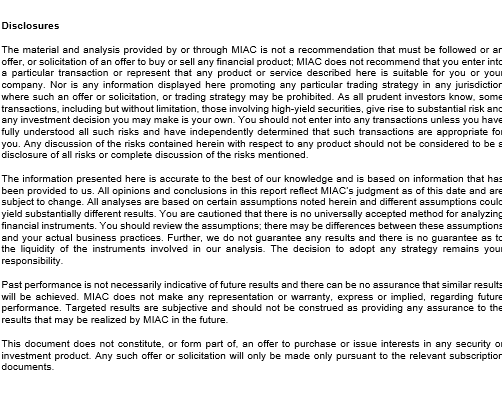By Dick Kazarian, Managing Director, Borrower Analytics Group
In this issue of MIAC Perspectives, we introduce our Lock Tracker™. We introduce this Lock Tracker to help market participants follow origination trends considering the unprecedented market volatility in rates and volume that we have experienced since the start of 2022.
Our data consists of applications processed by our Secondary Solutions Group (SSG) as of the initial lock date. The figures below include lock months between April 2022 and September 2022. We screened out reverse mortgages (mostly HECMs), second liens (both HELOCs and closed-end seconds), and Hybrids. Most originators do not do mandatory delivery for Hybrids, so this product type is under-represented in our data. It is important to emphasize that our conclusions below reflect our specific client base and will not necessarily reflect the overall residential market.
Our first two charts display locks grouped by client type. We classify our clients into four major groups: Independent Mortgage Banks (IMFs), Banks, Housing Finance Authorities (HFAs), and Credit Unions (CUs). When appropriate, we refer to Banks and Credit Unions together as depositories.
Figure 1 displays aggregate attributes across these client categories. CUs have the lowest average balances, while IMBs have the highest. Depositories have the better credits (higher FICOs, lower CLTVs, and lower DTIs), while HFAs have the worst underwriting metrics. The retail channel is the most common across all client types but varies from a low of 63% (for IMBs) to a high of 100% (for HFAs). As recent press reports make clear, numerous originators are looking to exit either the broker or the correspondent channels (or both).
Figure 1: Characteristics by Client Type Source: MIAC Analytics™
A more detailed product breakdown across client types is displayed in Figure 2. As expected, the product mix varies greatly across client categories. Depositories (Banks and CUs) focus more on Conventionals relative to FHA/VA and have the highest share of the shorter duration CONV-15. Due to non-payment of insurance claims and legal issues regarding the False Claims Act, depositories have stepped away from originating and servicing FHA loans in the aftermath of the Great Financial Crisis (GFC). In contrast to depositories, HFAs are balanced between CONV-30 and FHA-30. HFAs mostly target first-time homebuyers with relatively high DTIs and small down payments. As a result, they originate almost no 15-year product. IMBs have the most diverse product mix and are active in most product segments.
Figure 2: Product Detail by Client Type (Product Detail) Source: MIAC Analytics™
Next, we segment our data by product type and examine their average attributes (see results in Figure 3). Several observations merit elaboration. First, average balances vary significantly across product segments. They are smallest for FHA/USDA and largest for Conventional, with VA in between. Across all sectors, 15-year products have much lower balances than 30-year products. These shorter maturity products also have lower LTVs and are much more likely to be used for refinances rather than for purchase transactions. Given the rate sell-off, we expect the 15-year product sector to decline significantly along with the refinance share more generally.
Second, average LTVs also display significant variation, from a low of 66 in CONV-15 to a high of 98 in USDA-30. Broadly speaking, LTVs are much higher in the Government-insured sectors (FHA, VA, and USDA) than in Conventionals.
Third, underwriting attributes (DTI and FICO) are worse for those product segments that also have higher LTVs. This relationship is well known among mortgage market participants and is referred to as layered risk. For example, FHA-30 DTIs are 12 points higher than CONV-15 DTIs, while their average FICOs are 87 points lower. Both attributes are big drivers of credit risk. If we look at the quantiles of DTI and FICO (e.g., the percentage of loans with a DTI above 50), the credit risk of the Government-insured sector would look even worse. Further, as we have shown previously, FHA loans have higher credit risk than VA or Conventional loans even after adjusting for their worse attributes. The segmentation of credit risk between Conventional, FHA and VA loans is a distinguishing feature of our CORE™ Residential Model Suite.
Figure 3: Attributes by Product Type Source: MIAC Analytics™
Figure 4: Attributes by Lock Month Source: MIAC Analytics™
Figure 4 displays attributes across lock dates. Mortgage rates increased dramatically over this period, from 5.08 to 5.92. This rate sell-off is even larger when using month-end snapshots as opposed to monthly averages (as shown in Figure 1 of our Market Overview article). Average DTIs and LTVs have been mostly stable over this six-month period, but we expect future increases in these variables as the purchase share continues to increase and affordability wanes. FICOs have dropped by 10 points. Our Core model predicts that AC->D30 transition rates will increase by 10-15% as a result.
Summary
Locks trends are an early indicator for new originations and subsequent securitizations. We believe that as a result of declining affordability and rising rates, the characteristics of new originations could change dramatically over the next few quarters. MIAC has introduced this Lock Tracker to provide market participants more visibility into these emerging trends. We welcome feedback from our readers.
MIAC Perspectives: Loan Tracker
Author
Dick Kazarian, Managing Director, Borrower Analytics Group
Dick.Kazarian@miacanalytics.com
View MIAC Perspectives – Fall 2022 Issue
